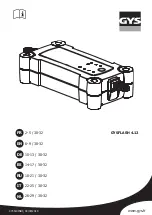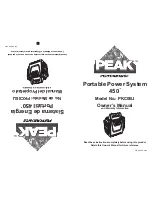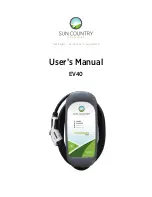
5
CHARGING
Before charging your batteries, it is critical that you determine the maximum allowable charge rate for your
batteries. The Power Peak D7 is capable of charging at high rates that may not be suitable or safe for your
particular batteries. For example, Lithium cells are typically safe to charge at 1C, or the total mAh÷1000. A
1200mAh battery would have a 1C charge rate of 1.2 amps. A 4200mAh battery would have a 1C charge rate of
4.2 amps. Some manufacturers are offering Lithium cells that can be charged at greater than 1C but this should
ALWAYS be verified before charging a Lithium battery at rates higher than 1C. Voltage is just as critical as the
charging amperage rate and this is determined by the number of cells in series, or “S”. For example, a 3S LiPo is
rated at 11.1 volts (“S” multiplied by a single LiPo cell with a nominal voltage of 3.7 volts DC. 3 cells x 3.7 volts
each equals 11.1 volts DC).
Connect the battery’s main leads to the charger output: red is positive and black is negative. Keep in mind that
the gauge or thickness of your charging leads from the Power Peak D7 to your battery must be of an acceptable
current rating to handle the applied charge current. For maximum safety and charging effectiveness, always
match or exceed the main battery lead rating when assembling or selecting your charging leads. If you charge a
battery at a high current rate (amperage) with a charging lead not rated for the chosen amperage, the wire could
get hot, catch fire, short out and/or potentially destroy your battery and the charger. When in doubt, always use a
higher gauge wire (lower AWG number). It is common to see charging leads constructed of 14AWG, 16AWG or
18AWG wire.
Always refer to recommendations from your battery manufacturer for your specific battery type and size before
initiating a charge or discharge process.
Do not attempt to disassemble or modify Lithium or Lead-Acid battery packs.
DISCHARGING
The Power Peak D7 discharging functions are for two specific purposes:
•
Refreshing the capacity of a Nickel-based battery that has lost capacity over time (NiMH or NiCd).
•
Reducing the voltage of a Lithium battery for safe storage.
LITHIUM CHEMISTRY BATTERY PACKS SHOULD ONLY BE DISCHARGED TO THEIR
MINIMUM SAFE VOLTAGE, NO LOWER. DEEP DISCHARGING A LITHIUM CELL WILL
DO PERMANENT DAMAGE. REFER TO THE STANDARD BATTERY PARAMETERS
TABLE ON PAGE 6 OF THIS MANUAL FOR MINIMUM DISCHARGE VOLTAGES.
LiPo & LiHV Charge/Discharge Cycling
Lithium batteries are known to reach full capacity after a break-in period of about 10 charge/discharge cycles.
We do not recommend you use the Power Peak D7 charger to do this; normal use and recharging will achieve
the same results. If you wish to perform a Lithium break-in on the bench with the Power Peak D7, discharging
to minimum acceptable voltages and performing a balance charge at 1C maximum rate is recommended. If you
choose to break in your Lithium batteries under normal use, charging at only 1C for the first ten cycles will help
ensure full performance and service life from your Lithium cells.
WARNINGS and SAFETY NOTES (CONT.)
Note






































